Nursing Leadership and Patient Safety
VerifiedAdded on 2020/02/24
|8
|1698
|62
Essay
AI Summary
This essay discusses the impact of various nursing leadership styles on patient safety, focusing on transformational, transactional, and laissez-faire approaches. It highlights how these styles influence the prevention of medical errors and improve healthcare outcomes. The paper emphasizes the importance of effective leadership in nursing to ensure optimal patient care and safety.

Nursing Leadership
Student’s Name
Institution Affiliation
Student’s Name
Institution Affiliation
Paraphrase This Document
Need a fresh take? Get an instant paraphrase of this document with our AI Paraphraser
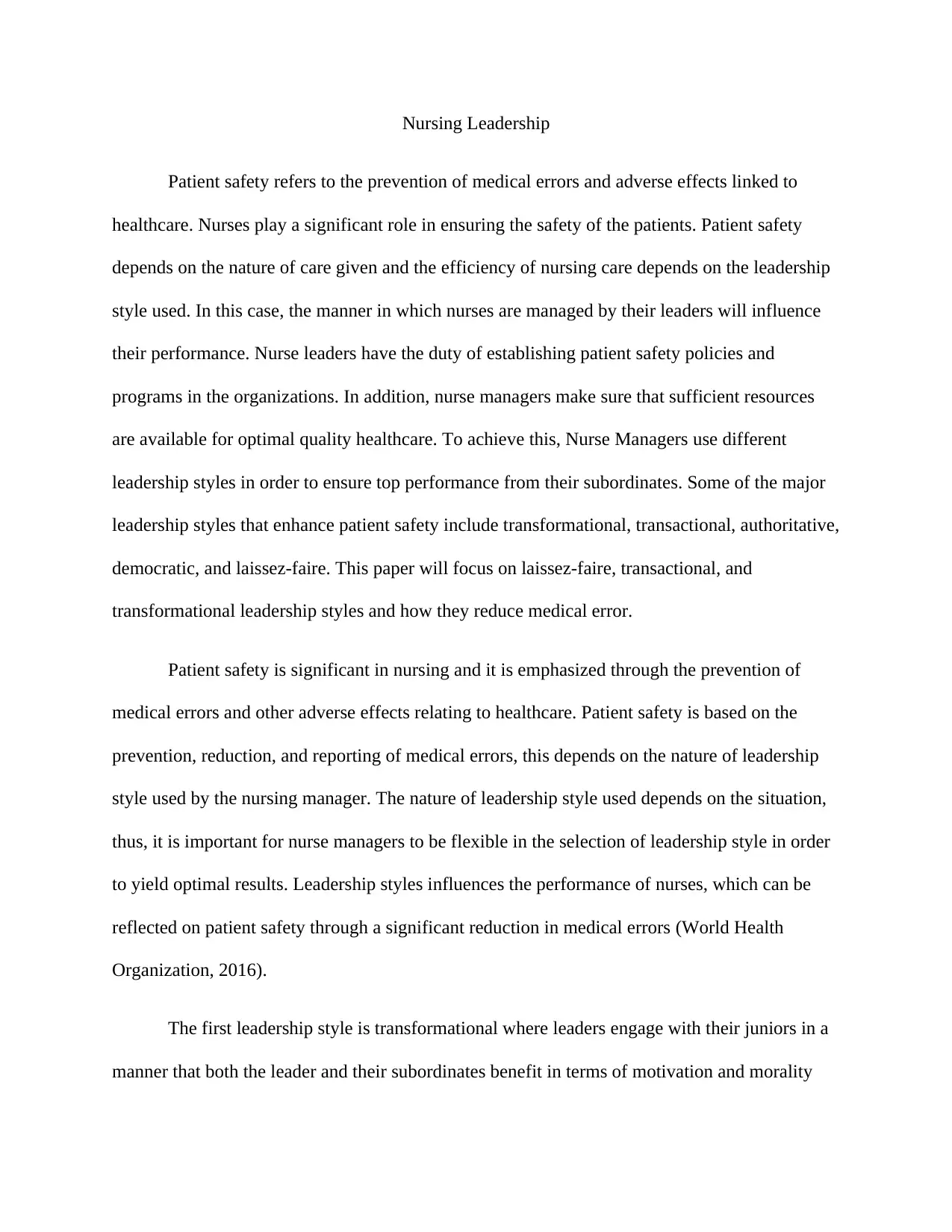
Nursing Leadership
Patient safety refers to the prevention of medical errors and adverse effects linked to
healthcare. Nurses play a significant role in ensuring the safety of the patients. Patient safety
depends on the nature of care given and the efficiency of nursing care depends on the leadership
style used. In this case, the manner in which nurses are managed by their leaders will influence
their performance. Nurse leaders have the duty of establishing patient safety policies and
programs in the organizations. In addition, nurse managers make sure that sufficient resources
are available for optimal quality healthcare. To achieve this, Nurse Managers use different
leadership styles in order to ensure top performance from their subordinates. Some of the major
leadership styles that enhance patient safety include transformational, transactional, authoritative,
democratic, and laissez-faire. This paper will focus on laissez-faire, transactional, and
transformational leadership styles and how they reduce medical error.
Patient safety is significant in nursing and it is emphasized through the prevention of
medical errors and other adverse effects relating to healthcare. Patient safety is based on the
prevention, reduction, and reporting of medical errors, this depends on the nature of leadership
style used by the nursing manager. The nature of leadership style used depends on the situation,
thus, it is important for nurse managers to be flexible in the selection of leadership style in order
to yield optimal results. Leadership styles influences the performance of nurses, which can be
reflected on patient safety through a significant reduction in medical errors (World Health
Organization, 2016).
The first leadership style is transformational where leaders engage with their juniors in a
manner that both the leader and their subordinates benefit in terms of motivation and morality
Patient safety refers to the prevention of medical errors and adverse effects linked to
healthcare. Nurses play a significant role in ensuring the safety of the patients. Patient safety
depends on the nature of care given and the efficiency of nursing care depends on the leadership
style used. In this case, the manner in which nurses are managed by their leaders will influence
their performance. Nurse leaders have the duty of establishing patient safety policies and
programs in the organizations. In addition, nurse managers make sure that sufficient resources
are available for optimal quality healthcare. To achieve this, Nurse Managers use different
leadership styles in order to ensure top performance from their subordinates. Some of the major
leadership styles that enhance patient safety include transformational, transactional, authoritative,
democratic, and laissez-faire. This paper will focus on laissez-faire, transactional, and
transformational leadership styles and how they reduce medical error.
Patient safety is significant in nursing and it is emphasized through the prevention of
medical errors and other adverse effects relating to healthcare. Patient safety is based on the
prevention, reduction, and reporting of medical errors, this depends on the nature of leadership
style used by the nursing manager. The nature of leadership style used depends on the situation,
thus, it is important for nurse managers to be flexible in the selection of leadership style in order
to yield optimal results. Leadership styles influences the performance of nurses, which can be
reflected on patient safety through a significant reduction in medical errors (World Health
Organization, 2016).
The first leadership style is transformational where leaders engage with their juniors in a
manner that both the leader and their subordinates benefit in terms of motivation and morality
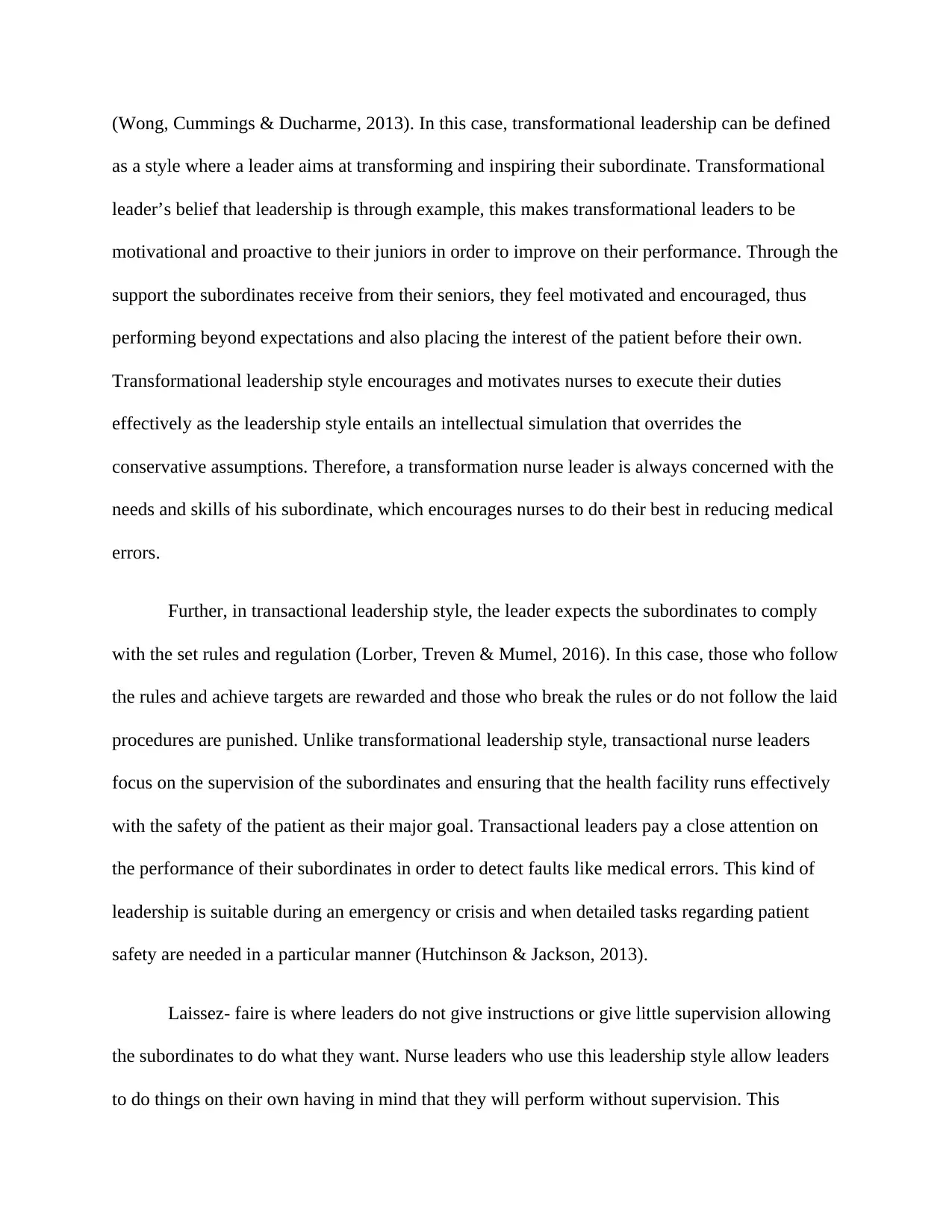
(Wong, Cummings & Ducharme, 2013). In this case, transformational leadership can be defined
as a style where a leader aims at transforming and inspiring their subordinate. Transformational
leader’s belief that leadership is through example, this makes transformational leaders to be
motivational and proactive to their juniors in order to improve on their performance. Through the
support the subordinates receive from their seniors, they feel motivated and encouraged, thus
performing beyond expectations and also placing the interest of the patient before their own.
Transformational leadership style encourages and motivates nurses to execute their duties
effectively as the leadership style entails an intellectual simulation that overrides the
conservative assumptions. Therefore, a transformation nurse leader is always concerned with the
needs and skills of his subordinate, which encourages nurses to do their best in reducing medical
errors.
Further, in transactional leadership style, the leader expects the subordinates to comply
with the set rules and regulation (Lorber, Treven & Mumel, 2016). In this case, those who follow
the rules and achieve targets are rewarded and those who break the rules or do not follow the laid
procedures are punished. Unlike transformational leadership style, transactional nurse leaders
focus on the supervision of the subordinates and ensuring that the health facility runs effectively
with the safety of the patient as their major goal. Transactional leaders pay a close attention on
the performance of their subordinates in order to detect faults like medical errors. This kind of
leadership is suitable during an emergency or crisis and when detailed tasks regarding patient
safety are needed in a particular manner (Hutchinson & Jackson, 2013).
Laissez- faire is where leaders do not give instructions or give little supervision allowing
the subordinates to do what they want. Nurse leaders who use this leadership style allow leaders
to do things on their own having in mind that they will perform without supervision. This
as a style where a leader aims at transforming and inspiring their subordinate. Transformational
leader’s belief that leadership is through example, this makes transformational leaders to be
motivational and proactive to their juniors in order to improve on their performance. Through the
support the subordinates receive from their seniors, they feel motivated and encouraged, thus
performing beyond expectations and also placing the interest of the patient before their own.
Transformational leadership style encourages and motivates nurses to execute their duties
effectively as the leadership style entails an intellectual simulation that overrides the
conservative assumptions. Therefore, a transformation nurse leader is always concerned with the
needs and skills of his subordinate, which encourages nurses to do their best in reducing medical
errors.
Further, in transactional leadership style, the leader expects the subordinates to comply
with the set rules and regulation (Lorber, Treven & Mumel, 2016). In this case, those who follow
the rules and achieve targets are rewarded and those who break the rules or do not follow the laid
procedures are punished. Unlike transformational leadership style, transactional nurse leaders
focus on the supervision of the subordinates and ensuring that the health facility runs effectively
with the safety of the patient as their major goal. Transactional leaders pay a close attention on
the performance of their subordinates in order to detect faults like medical errors. This kind of
leadership is suitable during an emergency or crisis and when detailed tasks regarding patient
safety are needed in a particular manner (Hutchinson & Jackson, 2013).
Laissez- faire is where leaders do not give instructions or give little supervision allowing
the subordinates to do what they want. Nurse leaders who use this leadership style allow leaders
to do things on their own having in mind that they will perform without supervision. This
⊘ This is a preview!⊘
Do you want full access?
Subscribe today to unlock all pages.

Trusted by 1+ million students worldwide
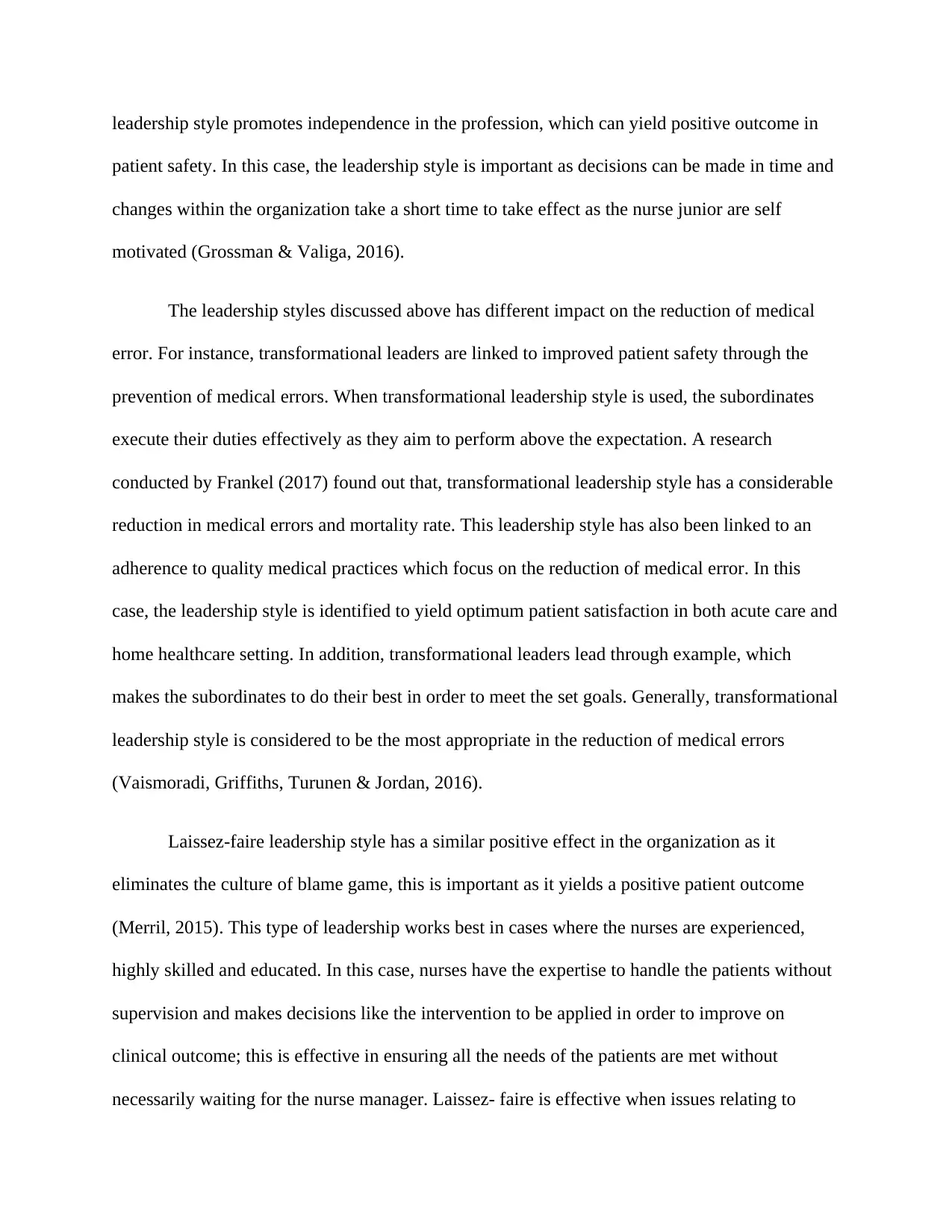
leadership style promotes independence in the profession, which can yield positive outcome in
patient safety. In this case, the leadership style is important as decisions can be made in time and
changes within the organization take a short time to take effect as the nurse junior are self
motivated (Grossman & Valiga, 2016).
The leadership styles discussed above has different impact on the reduction of medical
error. For instance, transformational leaders are linked to improved patient safety through the
prevention of medical errors. When transformational leadership style is used, the subordinates
execute their duties effectively as they aim to perform above the expectation. A research
conducted by Frankel (2017) found out that, transformational leadership style has a considerable
reduction in medical errors and mortality rate. This leadership style has also been linked to an
adherence to quality medical practices which focus on the reduction of medical error. In this
case, the leadership style is identified to yield optimum patient satisfaction in both acute care and
home healthcare setting. In addition, transformational leaders lead through example, which
makes the subordinates to do their best in order to meet the set goals. Generally, transformational
leadership style is considered to be the most appropriate in the reduction of medical errors
(Vaismoradi, Griffiths, Turunen & Jordan, 2016).
Laissez-faire leadership style has a similar positive effect in the organization as it
eliminates the culture of blame game, this is important as it yields a positive patient outcome
(Merril, 2015). This type of leadership works best in cases where the nurses are experienced,
highly skilled and educated. In this case, nurses have the expertise to handle the patients without
supervision and makes decisions like the intervention to be applied in order to improve on
clinical outcome; this is effective in ensuring all the needs of the patients are met without
necessarily waiting for the nurse manager. Laissez- faire is effective when issues relating to
patient safety. In this case, the leadership style is important as decisions can be made in time and
changes within the organization take a short time to take effect as the nurse junior are self
motivated (Grossman & Valiga, 2016).
The leadership styles discussed above has different impact on the reduction of medical
error. For instance, transformational leaders are linked to improved patient safety through the
prevention of medical errors. When transformational leadership style is used, the subordinates
execute their duties effectively as they aim to perform above the expectation. A research
conducted by Frankel (2017) found out that, transformational leadership style has a considerable
reduction in medical errors and mortality rate. This leadership style has also been linked to an
adherence to quality medical practices which focus on the reduction of medical error. In this
case, the leadership style is identified to yield optimum patient satisfaction in both acute care and
home healthcare setting. In addition, transformational leaders lead through example, which
makes the subordinates to do their best in order to meet the set goals. Generally, transformational
leadership style is considered to be the most appropriate in the reduction of medical errors
(Vaismoradi, Griffiths, Turunen & Jordan, 2016).
Laissez-faire leadership style has a similar positive effect in the organization as it
eliminates the culture of blame game, this is important as it yields a positive patient outcome
(Merril, 2015). This type of leadership works best in cases where the nurses are experienced,
highly skilled and educated. In this case, nurses have the expertise to handle the patients without
supervision and makes decisions like the intervention to be applied in order to improve on
clinical outcome; this is effective in ensuring all the needs of the patients are met without
necessarily waiting for the nurse manager. Laissez- faire is effective when issues relating to
Paraphrase This Document
Need a fresh take? Get an instant paraphrase of this document with our AI Paraphraser
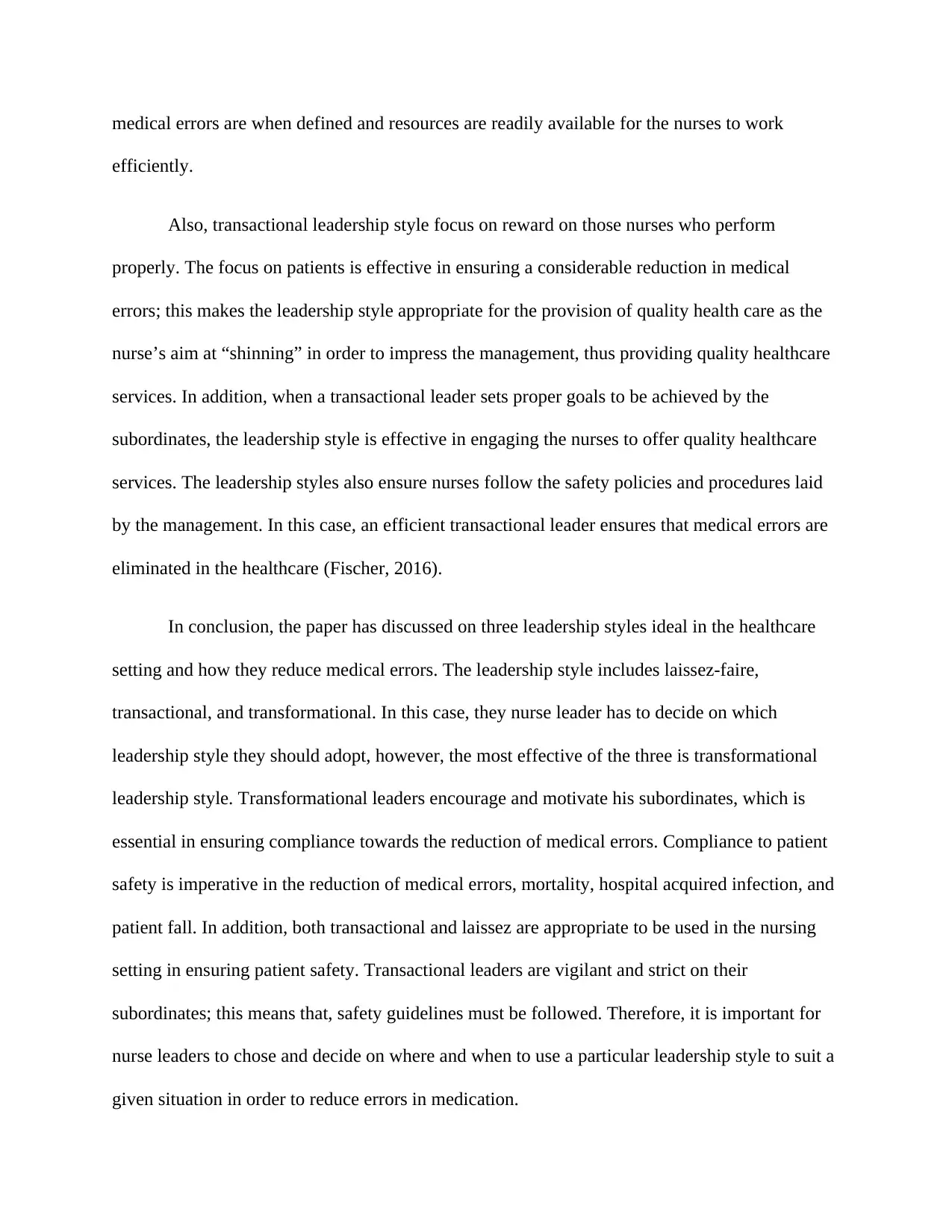
medical errors are when defined and resources are readily available for the nurses to work
efficiently.
Also, transactional leadership style focus on reward on those nurses who perform
properly. The focus on patients is effective in ensuring a considerable reduction in medical
errors; this makes the leadership style appropriate for the provision of quality health care as the
nurse’s aim at “shinning” in order to impress the management, thus providing quality healthcare
services. In addition, when a transactional leader sets proper goals to be achieved by the
subordinates, the leadership style is effective in engaging the nurses to offer quality healthcare
services. The leadership styles also ensure nurses follow the safety policies and procedures laid
by the management. In this case, an efficient transactional leader ensures that medical errors are
eliminated in the healthcare (Fischer, 2016).
In conclusion, the paper has discussed on three leadership styles ideal in the healthcare
setting and how they reduce medical errors. The leadership style includes laissez-faire,
transactional, and transformational. In this case, they nurse leader has to decide on which
leadership style they should adopt, however, the most effective of the three is transformational
leadership style. Transformational leaders encourage and motivate his subordinates, which is
essential in ensuring compliance towards the reduction of medical errors. Compliance to patient
safety is imperative in the reduction of medical errors, mortality, hospital acquired infection, and
patient fall. In addition, both transactional and laissez are appropriate to be used in the nursing
setting in ensuring patient safety. Transactional leaders are vigilant and strict on their
subordinates; this means that, safety guidelines must be followed. Therefore, it is important for
nurse leaders to chose and decide on where and when to use a particular leadership style to suit a
given situation in order to reduce errors in medication.
efficiently.
Also, transactional leadership style focus on reward on those nurses who perform
properly. The focus on patients is effective in ensuring a considerable reduction in medical
errors; this makes the leadership style appropriate for the provision of quality health care as the
nurse’s aim at “shinning” in order to impress the management, thus providing quality healthcare
services. In addition, when a transactional leader sets proper goals to be achieved by the
subordinates, the leadership style is effective in engaging the nurses to offer quality healthcare
services. The leadership styles also ensure nurses follow the safety policies and procedures laid
by the management. In this case, an efficient transactional leader ensures that medical errors are
eliminated in the healthcare (Fischer, 2016).
In conclusion, the paper has discussed on three leadership styles ideal in the healthcare
setting and how they reduce medical errors. The leadership style includes laissez-faire,
transactional, and transformational. In this case, they nurse leader has to decide on which
leadership style they should adopt, however, the most effective of the three is transformational
leadership style. Transformational leaders encourage and motivate his subordinates, which is
essential in ensuring compliance towards the reduction of medical errors. Compliance to patient
safety is imperative in the reduction of medical errors, mortality, hospital acquired infection, and
patient fall. In addition, both transactional and laissez are appropriate to be used in the nursing
setting in ensuring patient safety. Transactional leaders are vigilant and strict on their
subordinates; this means that, safety guidelines must be followed. Therefore, it is important for
nurse leaders to chose and decide on where and when to use a particular leadership style to suit a
given situation in order to reduce errors in medication.

⊘ This is a preview!⊘
Do you want full access?
Subscribe today to unlock all pages.

Trusted by 1+ million students worldwide
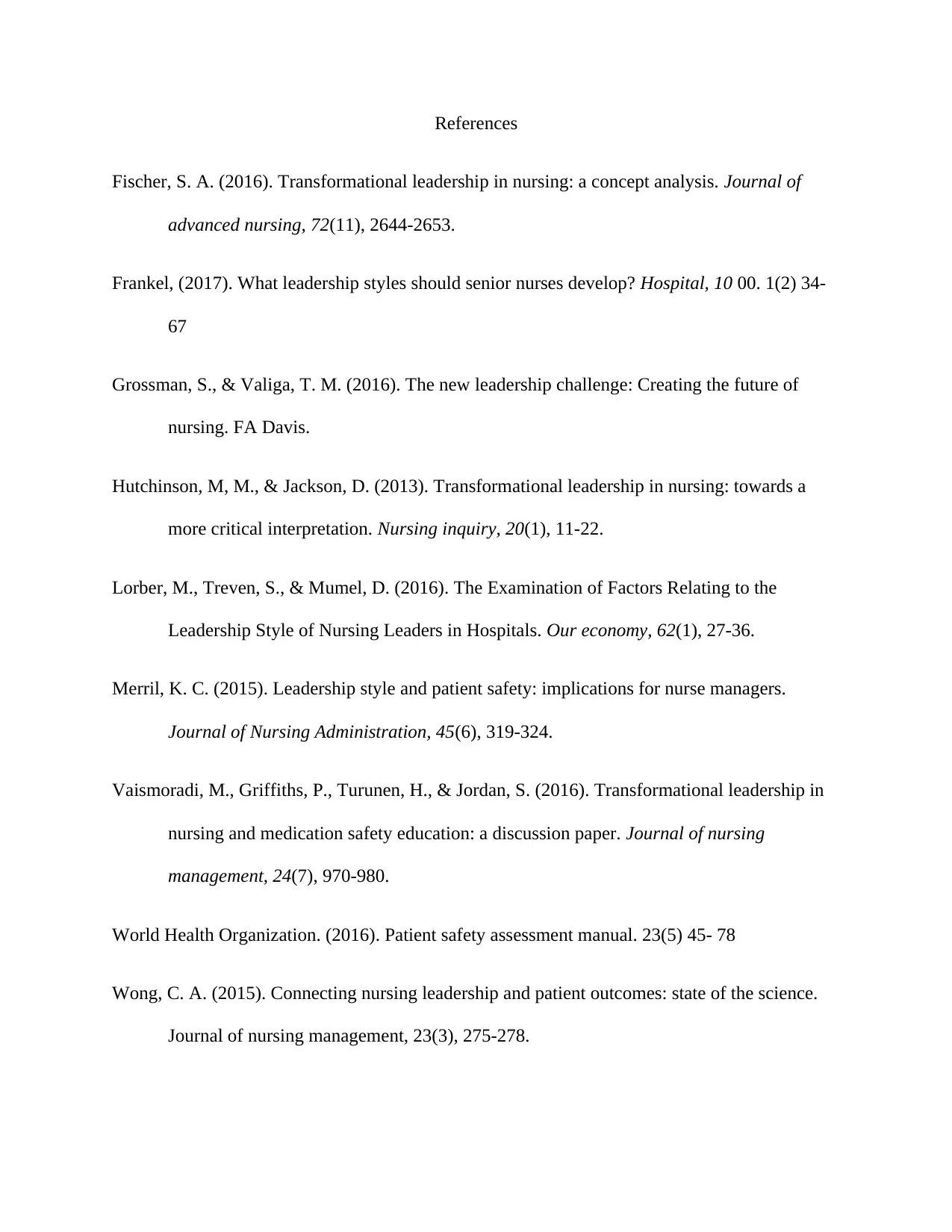
References
Fischer, S. A. (2016). Transformational leadership in nursing: a concept analysis. Journal of
advanced nursing, 72(11), 2644-2653.
Frankel, (2017). What leadership styles should senior nurses develop? Hospital, 10 00. 1(2) 34-
67
Grossman, S., & Valiga, T. M. (2016). The new leadership challenge: Creating the future of
nursing. FA Davis.
Hutchinson, M, M., & Jackson, D. (2013). Transformational leadership in nursing: towards a
more critical interpretation. Nursing inquiry, 20(1), 11-22.
Lorber, M., Treven, S., & Mumel, D. (2016). The Examination of Factors Relating to the
Leadership Style of Nursing Leaders in Hospitals. Our economy, 62(1), 27-36.
Merril, K. C. (2015). Leadership style and patient safety: implications for nurse managers.
Journal of Nursing Administration, 45(6), 319-324.
Vaismoradi, M., Griffiths, P., Turunen, H., & Jordan, S. (2016). Transformational leadership in
nursing and medication safety education: a discussion paper. Journal of nursing
management, 24(7), 970-980.
World Health Organization. (2016). Patient safety assessment manual. 23(5) 45- 78
Wong, C. A. (2015). Connecting nursing leadership and patient outcomes: state of the science.
Journal of nursing management, 23(3), 275-278.
Fischer, S. A. (2016). Transformational leadership in nursing: a concept analysis. Journal of
advanced nursing, 72(11), 2644-2653.
Frankel, (2017). What leadership styles should senior nurses develop? Hospital, 10 00. 1(2) 34-
67
Grossman, S., & Valiga, T. M. (2016). The new leadership challenge: Creating the future of
nursing. FA Davis.
Hutchinson, M, M., & Jackson, D. (2013). Transformational leadership in nursing: towards a
more critical interpretation. Nursing inquiry, 20(1), 11-22.
Lorber, M., Treven, S., & Mumel, D. (2016). The Examination of Factors Relating to the
Leadership Style of Nursing Leaders in Hospitals. Our economy, 62(1), 27-36.
Merril, K. C. (2015). Leadership style and patient safety: implications for nurse managers.
Journal of Nursing Administration, 45(6), 319-324.
Vaismoradi, M., Griffiths, P., Turunen, H., & Jordan, S. (2016). Transformational leadership in
nursing and medication safety education: a discussion paper. Journal of nursing
management, 24(7), 970-980.
World Health Organization. (2016). Patient safety assessment manual. 23(5) 45- 78
Wong, C. A. (2015). Connecting nursing leadership and patient outcomes: state of the science.
Journal of nursing management, 23(3), 275-278.
Paraphrase This Document
Need a fresh take? Get an instant paraphrase of this document with our AI Paraphraser

Wong, C. A., Cummings, G. G., & Ducharme, L. (2013). The relationship between nursing
leadership and patient outcomes: a systematic review update. Journal of nursing
management, 21(5), 709-724.
leadership and patient outcomes: a systematic review update. Journal of nursing
management, 21(5), 709-724.
1 out of 8
Related Documents
Your All-in-One AI-Powered Toolkit for Academic Success.
+13062052269
info@desklib.com
Available 24*7 on WhatsApp / Email
![[object Object]](/_next/static/media/star-bottom.7253800d.svg)
Unlock your academic potential
Copyright © 2020–2025 A2Z Services. All Rights Reserved. Developed and managed by ZUCOL.





